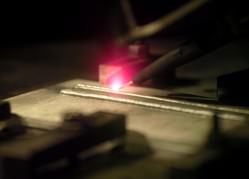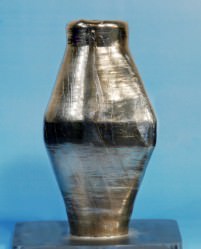EBF3150 works in a vacuum chamber, where an electron beam is focused on a constantly feeding source of metal, which is melted and then applied layer by layer on top of a rotating surface until the part is complete. A detailed 3-dimensional cross-sectional drawing of the part is fed into the device's computer, providing information of how the the part should be built from the inside out. This guides the electron beam and and the inflow of metal to produce the object, building it up layer by layer. Commercial applications for EBF3150 are already known and its potential already tested, Taminger said, noting it's possible that, within a few years, some aircraft will be flying with parts made by this process. The metals used must be compatible with the electron beam so that it can be heated by the stream of energy and briefly turned into liquid form. Aluminum is an ideal material to be used, but other metals can be used as well. In fact, the EBF3150 can handle two different sources of the feed stock metal at the same time, either by mixing them together into a unique alloy or embedding one material inside another, such as inserting a strand of fiber optic glass inside an aluminum part, enabling the placement of sensors in areas that were impossible before, Taminger said. Future lunar base crews could use EBF3 to manufacture spare parts as needed, rather than rely on a supply of parts launched from Earth. Astronauts might be able to mine feed stock from the lunar soil, or even recycle used landing craft stages by melting them. But the immediate and greatest potential for the process is in the aviation industry where major structural segments of an airliner, or casings for a jet engine, could be manufactured for about $1,000 per pound less than conventional means, Taminger said. The device is environmentally friendly because its unique manufacturing technique cuts down on the amount of waste. Normally an aircraft builder might start with a 6,000-pound block of titanium and machine it down to a 300-pound part, leaving 5,700 pounds of material that needs to be recycled and using several thousand gallons of cutting fluid used in the process. "With EBF3 you can build up the same part using only 350 pounds of titanium and machine away just 50 pounds to get the part into its final configuration," Taminger said. "And the EBF3 process uses much less electricity to create the same part." While initial parts for the aviation industry will be simple shapes, replacing parts already designed, future parts designed from scratch with the EBF3150 process in mind could lead to improvements in jet engine efficiency, fuel burn rate and component lifetime. "There's a lot of power in being able to build up your part layer by layer because you can get internal cavities and complexities that are not possible with machining from a solid block of material," Taminger said.
It's not quite like requesting "Tea, Earl Grey, hot" and having a steaming drink appear, but almost. The Electron Beam Freeform Fabrication, developed at NASA's Langley Research Center, is an engineer's version of the science fiction replicator on Star Trek. "You start with a drawing of the part you want to build, you push a button, and out comes the part," said Karen Taminger, the technology lead for NASA's Fundamental Aeronautics Program.
Electron Beam Freeform Fabrication or EBF3150 creates parts for airplanes — not food and drink — and uses an environmentally-friendly construction process to manufacture layered metal objects. This technique could revolutionize the aviation industry and may have applications for the future spacecraft and the medical community as well. It can be used to make small, detailed parts or large structural pieces of airplanes.
While the EBF3 equipment tested on the ground is fairly large and heavy, a smaller version was created and successfully test flown on a NASA jet that is used to provide researchers with brief periods of weightlessness. The next step is to fly a demonstration of the hardware on the International Space Station, Taminger said.
Tuesday, September 29, 2009
NASA's Version of Star Trek Replicator Ready for On Orbit Test
Posted by KirkandSpock at 9:32 PM
Subscribe to:
Post Comments (Atom)



0 comments:
Post a Comment